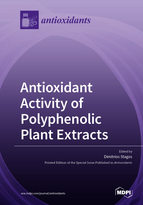Antioxidant Activity of Polyphenolic Plant Extracts
A special issue of Antioxidants (ISSN 2076-3921). This special issue belongs to the section "Natural and Synthetic Antioxidants".
Deadline for manuscript submissions: closed (30 April 2019) | Viewed by 158519
Special Issue Editor
Interests: antioxidant activity of plant extracts; plant polyphenols and other natural products; physiological adaptive mechanisms of human organism to oxidative stress conditions; chemopreventive (anticarcinogenic) activity of plant extracts, plant polyphenols and other natural products; anti-angiogenic activity of chemical compounds (natural or synthetic)
Special Issues, Collections and Topics in MDPI journals
Special Issue Information
Dear Colleagues,
Plant polyphenols are secondary metabolites characterised by one or more hydroxyl groups binding to one or more aromatic rings. Several thousand polyphenolic molecules have been identified in higher plants, including edible ones. Plant polyphenols are divided into two major groups, flavonoids and non-flavonoids. Flavonoids can be divided into flavanols, flavonols, anthocyanidins, flavones, flavanones, and chalcones. Non-flavonoids include stilbene, phenolic acids, saponin, and tannins. Among the important biological properties exhibited by plant polyphenols, their antioxidant activity has raised a great interest . A number of studies have shown that plant polyphenols could be used as antioxidants against different oxidative stress-induced diseases. We invite you to submit your latest research findings or a review article to this Special Issue, which will bring together current research concerns and critical thinking on the antioxidant activity of polyphenolic plant extracts. The identification of the polyphenolic composition of plant extracts in the submitted articles is required. Your contribution can include both in vitro and in vivo studies relating to different aspects of the antioxidant activity of polyphenolic extracts, such as structure–activity relationships, regulation of endogenous antioxidant responses, and their role in signaling, metabolism, cell cycle, gene regulation, cellular stress, and prevention of diseases.
Dr. Dimitrios Stagos
Guest Editor
Manuscript Submission Information
Manuscripts should be submitted online at www.mdpi.com by registering and logging in to this website. Once you are registered, click here to go to the submission form. Manuscripts can be submitted until the deadline. All submissions that pass pre-check are peer-reviewed. Accepted papers will be published continuously in the journal (as soon as accepted) and will be listed together on the special issue website. Research articles, review articles as well as short communications are invited. For planned papers, a title and short abstract (about 100 words) can be sent to the Editorial Office for announcement on this website.
Submitted manuscripts should not have been published previously, nor be under consideration for publication elsewhere (except conference proceedings papers). All manuscripts are thoroughly refereed through a single-blind peer-review process. A guide for authors and other relevant information for submission of manuscripts is available on the Instructions for Authors page. Antioxidants is an international peer-reviewed open access monthly journal published by MDPI.
Please visit the Instructions for Authors page before submitting a manuscript. The Article Processing Charge (APC) for publication in this open access journal is 2900 CHF (Swiss Francs). Submitted papers should be well formatted and use good English. Authors may use MDPI's English editing service prior to publication or during author revisions.
Keywords
- antioxidant activity
- polyphenols
- plant extracts
Related Special Issues
- Mediterranean Edible Plants: An Assessment of Their Antioxidant, Radical Scavenger Properties and Their Use As Super Foods, Nutraceuticals, Functional Foods in Antioxidants (14 articles)
- Phenolic Profiling and Antioxidant Capacity in Plants in Antioxidants (55 articles)
- Antioxidant and Anti-inflammatory Properties of Plants Extract in Antioxidants (16 articles)
- Antioxidant Properties of Natural Products: A Themed Issue in Honor of Professor Isabel C.F.R. Ferreira in Antioxidants (24 articles)
- Anti-inflammatory and Antioxidant Properties of Plant Extracts in Antioxidants (23 articles)







